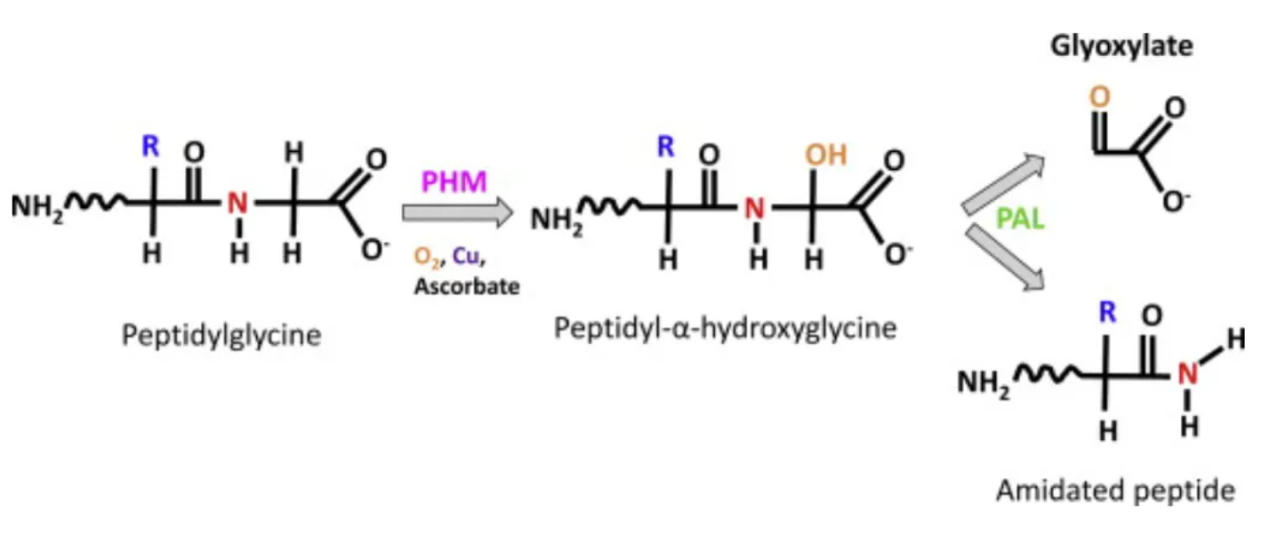Amidation Analysis Service
Amidation is an essential post-translational modification in which the C-terminal glycine residue of a peptide is converted into an amide group. This modification enhances peptide stability, receptor affinity, and biological potency, making it crucial for the activity of many hormones, neuropeptides, and signaling peptides.
To support both focused investigations and broader discovery studies, MtoZ Biolabs offers an integrated Amidation Analysis Service built on high-resolution LC–MS/MS, optimized enrichment workflows, and bioinformatics-based interpretation.
1. Target Protein Amidation Analysis
For projects centered on specific peptides or peptide hormones, MtoZ Biolabs provides targeted amidation analysis that identifies amidation sites, quantifies modification levels, and evaluates amidation efficiency under defined biological or experimental conditions. Techniques such as HPLC fractionation, immunoaffinity capture, and chemical derivatization can be applied to enhance detection sensitivity and ensure accurate site confirmation.
2. Amidation Proteomics
For system-level studies, our amidation proteomics workflow enables large-scale profiling of amidated peptides across complex biological samples. Through high-throughput enrichment, LC–MS/MS acquisition, and bioinformatics analysis, we map amidation events globally and reveal functional networks influenced by this modification.
What is Amidation?
Amidation is a highly conserved enzymatic process that plays a central role in peptide maturation. The reaction is catalyzed by peptidylglycine α-amidating monooxygenase (PAM), a bifunctional enzyme that requires copper, molecular oxygen, and ascorbate as cofactors. It proceeds through two sequential steps: hydroxylation of the terminal glycine to generate an unstable intermediate, followed by cleavage to release glyoxylate and form the amidated peptide. This modification takes place predominantly in neuroendocrine tissues and secretory pathways, reflecting its essential role in peptide signaling.

Kumar, D. et al. 2014.
Figure 1. The Amidation Reaction Catalyzed by PAM
The biological consequences of amidation are profound. Amidated peptides exhibit increased resistance to proteolysis, optimized receptor-binding affinity, and enhanced signaling efficacy compared to their non-amidated counterparts. Well-studied examples include neuropeptides such as substance P and neuropeptide Y, and hormones like oxytocin, vasopressin, and calcitonin, all of which require amidation for their physiological activity. Accurate characterization of these modifications requires optimized workflows that combine selective enrichment, high-resolution mass spectrometry, and bioinformatics-driven analysis.
Analysis Workflow

Sample Submission Suggestions
1. Sample Types
Cell lysates, tissues, biofluids (plasma, serum, CSF), synthetic peptides, or purified proteins. For other types, please contact us in advance for tailored preparation guidance.
2. Storage
Snap-freeze samples in liquid nitrogen and store at –80°C.
3. Shipping
Ship on dry ice to maintain modification stability.
4. Replicates
Biological replicates are recommended for statistical reliability.
Service Advantages
✅ Precision: Advanced enrichment techniques and high-resolution MS ensure accurate detection and site-level characterization of amidated peptides.
✅ Sensitivity: Capable of detecting low-abundance amidated peptides in complex biological samples.
✅ Comprehensiveness: From targeted detection to proteome-wide profiling, our services cover diverse research needs.
✅ Customization: Experimental workflows are tailored to specific project requirements and research objectives.
✅ Expertise: Our scientific team combines extensive knowledge in peptide biochemistry and proteomics with proven technical proficiency.
Applications
1. Neuropeptide and Hormone Regulation
Amidation is essential for the maturation and function of numerous neuropeptides and peptide hormones. Analysis of amidated peptides provides insights into their regulatory roles in appetite, stress response, reproductive processes, and cardiovascular control, advancing our understanding of endocrine and neuroendocrine systems.
2. Disease Mechanism Studies
Aberrant amidation has been linked to a range of pathological conditions, including metabolic disorders, cardiovascular dysfunction, neurodegenerative diseases, and cancer. Profiling amidation patterns helps reveal disease-associated mechanisms and supports the identification of potential biomarkers for diagnosis and prognosis.
3. Drug Development and Target Identification
The improved stability and receptor-binding affinity conferred by amidation make amidated peptides attractive candidates for therapeutic development. Systematic evaluation of amidation facilitates drug design, optimization of peptide-based therapeutics, and identification of novel molecular targets.
4. Protein Interactions and Signaling Pathways
Amidation influences peptide conformation and binding specificity, thereby modulating protein-protein interactions and downstream signaling cascades. Characterizing amidated peptides at a systems level contributes to mapping complex regulatory networks and understanding cellular communication.
Deliverables
1. Comprehensive Experimental Details
2. Materials, Instruments, and Methods
3. Total Ion Chromatogram & Quality Control Assessment
4. Data Analysis, Preprocessing, and Estimation
5. Bioinformatics Analysis
6. Raw Data Files
MtoZ Biolabs' high-quality Amidation Analysis Service combines precision, sensitivity, and comprehensive data interpretation, enabling researchers to achieve meaningful insights into peptide amidation and its biological roles. Contact us today to discuss your project and request a customized proposal!







